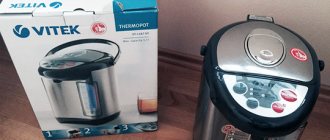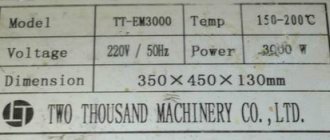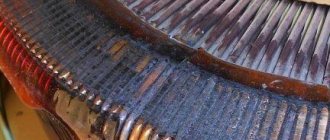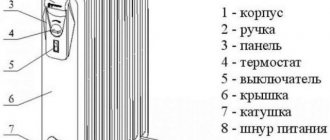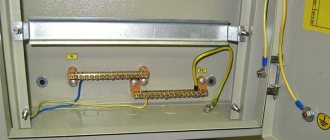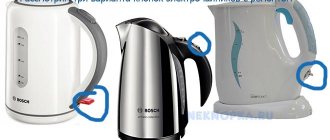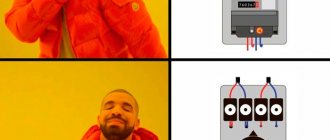There are three water supply buttons in the thermopot - one is a large pump button for manual injection located in the top cover, and two electric drive (pump) buttons, one on top on the control panel, the second behind the spout from which water flows, on the bottom. When you press any of them, water should flow from the spout.
If you have experience in repairing electrical appliances, then read on; if not, it’s better to take it to a service center.
It is necessary to determine which of the buttons does not work - a mechanical pump or an electric one. Arm yourself with a Phillips screwdriver and preferably have a multimeter.
All three buttons fail at once very rarely, this is if the seagull has not seen a lot of time and cleaning and maintenance.
The most common problem with electrical button failure is failure of the pump motor or clogging of the impeller and tubes with scale.
There is no way to do this without disassembling the thermopot. First of all, turn off the kettle from the 220 volt power supply. We turn it over and take out the belt on which the kettle is able to spin while standing, we see long screws (usually there are two or three of them). We unscrew the screws, remove the bottom cover and find ourselves in the bottom part of the kettle where the tube, the electronic control and power board, and the pump are located.
Usually in such a situation, the first thing I do is disassemble the pump. Separate the impeller and the engine
Sometimes there is a lot of scale in the impeller compartment, and not just small scale. Sometimes even the petals of exfoliated solid scale simply jam the impeller blades. Everything needs to be thoroughly cleaned.
We also clean the magnet from foreign objects and possible rust -
Reassemble in reverse order.
You should also ring both pump activation buttons with a tester to ensure they are making proper contact in the on position. The wires themselves rarely fail, but the soldering points may be poorly soldered - also check their contacts.
For deeper repairs, if the motor does not even hum, you should check for voltage at the motor terminals with the buttons turned on; the motor is usually designed for power in the range of 8 to 12 Volts DC. This is the voltage that should be supplied to it from the board.
If everything is normal with the voltage, most likely the stator winding of the pump motor has a break - here only a complete replacement is required, rewinding is not economically feasible.
Thermopot is an invention of modern civilization. This is a symbiosis of an electric kettle and a thermos, working on the principle of a samovar. Like a kettle, the thermopot boils water, and like a thermos, it keeps it hot for a long time. But this invention also has to be repaired sometimes. To start repairing a thermopot with your own hands, you need to study its internal structure and operating principle, therefore technical instructions are attached to the thermopot.
How does a thermopot work?
All such devices are designed the same, and may differ in auxiliary options. The working components of the thermopot are placed in the housing, and to repair the device it must be removed. Water is poured into a stainless steel tank with two heating elements in the bottom. One heating element heats the water to 100 o C, the second keeps it hot. All electrical parts are equipped with appropriate electrical protection.
A motor is attached to the side of the body, which supplies water from the reservoir. The device is also equipped with electronics that perform the functions of a time relay for re-boiling water and reducing the network voltage for the pump and time relay.
Also, the thermopot has a built-in automatic control board for reheating, indicating the status of the device and water supply. The thermal switch, which is duplicated by a thermal fuse, is mounted on the side wall of the tank and on the bottom of the housing. This protection prevents the thermopot from overheating or burning out.
If you know how the thermopot works and where everything is, it will be easier for you to identify the problem and repair the thermopot yourself. It won’t hurt to familiarize yourself with the electrical diagram of the device - then you can also repair some components yourself. For example, a power supply circuit for a Vitek thermopot can be purchased for about 1000-1200 rubles, and it consists of the following parts and components:
- Pulse transformer.
- Diode bridge.
- Elements of an electrical circuit: capacitors, resistors, diodes, transistors, etc.
Thus, a Panasonic NC-EH30PWTW thermopot costs about 5,000-6,000 rubles, and replacing electronics during repairs costs more than 2,000 rubles. The pump also costs about 2,000 rubles, so it is cheaper and easier to buy a new device than to repair an old device. However, if you still decide to repair the thermopot yourself, then start with the power cord.
The kettle turns off before the water boils: reasons, disassembly and DIY repairs
- insufficient knowledge, experience and self-confidence;
- The thermostat needs to be repaired or replaced;
- you need to repair the crack in the flask body;
- We have to work with a closed-type heating element.
Useful tips Connection diagrams Principles of operation of devices Main concepts Meters from Energomer Precautions Incandescent lamps Video instructions for the master Testing with a multimeter
| I couldn’t find any information on this problem on the internet, someone was also interested, but no answer, apparently the problem is unique to mystery. I decided to ask the experts what this blinking means? |
| Serg2278 wrote: |
| I couldn't find any information on this issue on the Internet. |
Disassembling the thermopot
Any deviation from the normal operation of the device can be called a breakdown requiring repair.
To remove the top housing, locate and remove the screws in the bottom of the unit. Next, make a visual inspection of all components for damage - mechanical and thermal, which can most often be repaired using a soldering iron.
The next step is to check the thermal switch in the bottom of the case using a regular household tester. A working switch does not have infinite resistance. Simply replace a non-working unit with a new one, and the easiest way to order it is via the Internet.
The pump can be disconnected only after disconnecting the supply tube and unscrewing the fastening bolts. Check it for clogging - often cleaning the impeller and magnet is enough to give the pump a second life.
Also, a standard thermopot, for example, Polaris or Boch, has not one, but several thermal switches, one of which is needed to control the water temperature, and the second protects the device from turning on if it is empty. The thermal switch is located so that the walls of the tank and the flange are in close contact. A special thermally conductive lubricant is used for contact.
How to fix simple breakdowns
Do not attempt to work with an unsuitable soldering iron, removing and replacing the microchip in the same Ideal ID-40TPS model or any other that requires the use of a hot air gun.
The most common faults can often be identified and corrected yourself. Here are some of them:
- The indicators do not light up, the device does not work and shows no signs of life. First, you should check the wiring and electrical connections, the fuse and the thermostat - these parts and assemblies fail more often than others.
- Only the reheat mode works - the main boiling does not work. Most likely, the bottom thermal switch is faulty or the main heating element has burned out.
- The main boiling mode works, reheating does not. Check the elements of the main board.
- The water supply is not working. The breakdown may be caused by a malfunction of the pump's power supply circuit or a breakdown of the pump itself. The additional heating coil (heating element), through which voltage is supplied to the pump motor, often burns out. If the heating elements fail, it is not economically profitable to repair the thermopot - it is cheaper to buy a new one, for example, scarlett SL-1509.
After completing the repair, check the electrical safety of the device - use the same tester to measure the resistance (it should be infinite) between the reservoir and the contacts of the electrical plug, between the body and the contacts of the plug.
When to take it to a specialist?
Device repair
Failures are not so simple. Then you can’t eliminate them with your own hands. If the microcircuits are completely out of order, the switch is covered, and the plate does not work, it means that the equipment was not operated correctly.
Now you need to calculate whether it makes sense to restore the kettle. What is its cost? How much will it cost to repair and purchase new equipment? What will be more profitable?
The most economical thing would be not only to buy good branded equipment with a guarantee. But also use it correctly: pour clean water, clean it on time and do not overheat. But if problems still arise, the instructions above will help you restore the device.
There are breakdowns that cannot be dealt with at home. In this case, you will have to seek the help of a specialist. If the plate, microcircuit or switch is faulty, it makes sense to wonder whether the kettle was used correctly.
A consultation with a service center specialist will help you decide whether repairs will help resolve the problem or whether it will be cheaper to purchase a new kettle. The repairman will tell you the cost of repairs immediately after diagnosing the malfunction, and you can look up the price of a new device in any store or on the Internet.
When deciding to buy a new electric kettle, try to purchase a product from a trusted manufacturer. Remember, a low price is not a guarantee that the device will work for a long time and properly. It is quite possible that the purchased budget option will stop working as soon as its warranty period ends. After making a purchase, treat the equipment with care, do not forget to provide it with proper care, and then the kettle will serve you faithfully for many years.
Repair of other thermopot elements
- If your thermopot's heating element burns out, you won't be able to repair it - you'll have to buy a new device. A new heating element costs 2,000 rubles and more, so replacing it in an old thermopot is simply unprofitable.
- Electrical cord. There is a block inside the case that secures the cord. It is necessary to release the cable and check it for short circuit with a tester.
- Microchip. It can be a feeder and a manager. A visual inspection will help identify burnt elements that can be replaced using a low-power soldering iron.
- Capacitors. The faulty part appears swollen and is immediately visible.
- Diodes rarely fail, and their performance can only be checked with a continuity tester.
- Getinaks board tracks. Microcracks can be tinned with a layer of tin solder.
We repair the kettle ourselves
If you find that the kettle has stopped turning off on its own, the first thing you need to do is inspect it for cracks and other damage to the body or lid. No cracks or damage were found, then the cause of the breakdown should be sought inside the case. Check that the filter is installed correctly, whether there is scale, and look into the steam outlet channel.
After an inspection that shows no visible faults, the kettle should be disassembled. During disassembly, the following causes of failure can be identified:
After completing the repair, the kettle should be assembled in the reverse order of its disassembly. How correctly the device is assembled can be easily checked using water. Pour water into the kettle and set it on any dry cloth for about half an hour. If there are no wet marks left on the fabric, then the device is assembled correctly and can be plugged into a power outlet.
Expert opinion
Viktor Pavlovich Strebizh, lighting and electrical expert
Any questions ask me, I will help!
A durable cord supplies voltage to contacts hidden deep inside the stand to prevent accidental contact with the human body. If there is something you don’t understand, write to me!
Video instructions for repairing a thermopot
Can a thermos boil water on its own? Of course it can if it is a thermopot. This is a combination of an electric kettle and a thermos. Like any piece of equipment, it is prone to breakdowns. Therefore, you need to figure out whether it is possible to repair a thermopot on your own?
Thermopot is a smart kettle. The difference is that:
- In addition to the water tank, it has an electric pump in its body;
- there is a control module;
- the flask retains heat and works like a thermos.
If hot water gradually cools down in a regular thermos, then our unit will maintain the set temperature as long as the device is plugged in. Therefore, all models are equipped with two heaters. One heating element boils water, the second maintains the set temperature. The exception is inexpensive devices that only have a boiling function.
There are models with different thermostats. The device is responsible for the temperature of the liquid. There is a stepless regulator that smoothly increases the heating from 60 to 100 degrees Celsius. And there is a stepped one, which has preset fixed positions. Many models use only three modes to control temperature indicators.
A pump is needed to supply hot water from the container to the cup.
It has several operating modes:
- auto-filling;
- manual bottling;
- pour using a lever on the spout.
The control module is mounted under the cover. The board is responsible for re-boiling using a time relay. And also for lowering the network voltage for the correct operation of the pump and time relay.
Each model has a thermal switch, which is controlled by a thermal fuse. Such protection is needed from overheating and combustion. Parts are attached to the bottom of the device body and the side wall.
If you do not have knowledge or experience in repairing electronics, it is advisable to contact a service center. But it’s still a good idea to have a general idea of how the thermopot circuit works. Then it will be possible to eliminate minor malfunctions without having any special education. For example, fix the power cord, remove and replace a faulty capacitor, or replace a burnt-out heating element or pump yourself.
The thermopot has a power supply. It consists of a pulse transformer and a diode bridge. We do not recommend going inside. Even specialists are unlikely to want to do repairs. Most likely, they will insist on a complete replacement. The elements of an electrical circuit connecting electrical parts include: capacitors, resistors, diodes, transistors, etc. They are mounted on the electrical board.
We have already mentioned the electric pump, control module and thermal protection. They are also included in the scheme. Let's look at a few repair cases that do not require in-depth knowledge.
How to fix the bottom button of an electric kettle
Operating principle and electrical diagram
Before you begin diagnosing or repairing a household kettle, you will need to find out what components it consists of and how it works. Despite the abundance of offers under different brands, all electrical devices in this category have a similar design. They include the following parts:
Next, a heating element (spiral or disk) installed at the bottom gradually brings the water in the tank to a boil. After boiling, the automatic switches off the power to the heater (the light goes out with a characteristic click). If there is not enough water in the kettle or it is accidentally turned on empty, the protection system should also work, de-energizing the power circuits.
Arrangement of electric kettle components
Both the old models with spiral heating elements and the new ones with disk-shaped heating elements remain similar in principle of operation and the presence of main components. They will definitely contain a heating element, a power button and a protection unit. Without them, the kettle will not work.
Overheat protection system
This unit is necessary to meet fire safety requirements. If it were not there, then if the water level was insufficient and an empty kettle was turned on, a fire would certainly have occurred. And so a special contact group will de-energize the heating element.
As a working tool, it uses a special plate made of 2 metals that reacts to heat. The normal position is closed; when overheated, the bimetal is deformed, breaking the power circuit, turning off the heating element. Manufacturers of household appliances use a number of standard solutions for this unit. And all use bimetallic sensors, which are reliable and efficient.
The only drawback of thermal protection is the need to wait until the working part cools down and returns to its original position. After this, the kettle is ready for use again.
Common faults
What may not work and how to understand the reasons.
- Not a single indicator light is lit on the display, and the kettle does not turn on. We check the power cord and each wire connection. We also check the thermostat, fuse, and control module.
- Pressing the button does not dispense water into the cup. The reason is the pump.
- Secondary boiling does not work, the thermos does not heat the water. We check the power module of the electrical board.
- Basic boiling doesn't work. Checking the thermostat.
- Only heating works. We check the heating element for boiling.
Now a little more detail - how to check this and what can be done to make everything work again.
Network wire
The power cord needs to be tested with a tester. If a problem is found, the wire is simply replaced with a new one.
Chip
Any thermopot has two modules. One for power, the other for control. We look at the details on the getinax boards, and check the boards themselves for the presence of microcracks. Burnt parts become charred and capacitors swell.
The parts can be desoldered and replaced by workers. Solder the cracks with a soldering iron. If the replaced part burns out again, then there is a short circuit somewhere and the whole unit will have to be replaced.
Heating elements
To check the condition of the heating element, you first need to unsolder it and then ring it. If it does burn out, then it is difficult to repair the heating element with your own hands. Easier to replace with a new one.
Doesn't pump water, pump doesn't work
It may not pump water due to a simple blockage.
It is not difficult to fix such a breakdown by disassembling and cleaning:
- Remove the hoses from the pump, disconnect the pump.
- Unscrew the impeller from the housing.
- Remove scale from the impeller.
- Remove the impeller and clean the magnet from dirt.
- If after cleaning the pump continues to not work, then the winding on the motor may have burned out, then you will have to buy a new pump. When installing the hoses back onto the fittings, secure them securely with clamps to prevent leakage.
Doesn't turn on or off
It happens that the thermopot does not turn off after boiling. And sometimes when you turn it on, the indicator will blink and immediately go out. In both cases, you need to check the thermal switches. In the normal position, the thermal switch contacts are closed. When the maximum temperature is reached they open. When the temperature drops by an average of 20 degrees, the contacts close again.
Check the thermal switch with a tester. To do this, you need to disconnect it. At room temperature, the tester should show 0 ohms. If the switch is placed in boiling water, then - infinity. In case of other indications, the part must be replaced. You also need to check whether the thermal paste, which is used for better contact with the surface, has dried out.
In case the thermal switch protection does not work, there is a thermal fuse that will open the circuit at a temperature of 110 to 150 degrees. Sometimes contact is simply not restored on it, then the fuse needs to be replaced.
Upon completion of work, check the electrical safety of the repaired device. There should be no contacts coming to the housing except grounding!
We looked at repair cases that can be handled without a specialist. In more complex cases, and even more so when you cannot understand what happened to your miracle kettle, you need to take it to a service center. Before repairing, find out how much it will cost. It might be better to buy a new smart kettle.
A thermopot is a small household appliance that combines the properties of two devices at once - an electric kettle and a thermos.
The main advantage is the ability to boil water and maintain its temperature in a given mode, as well as the ability to repair the thermopot yourself if such a need arises.
Replacing the pump if the thermopot does not pump water
- After removing the metal casing, disconnect the tubes from the pump. If you find scale on the wires, you need to get rid of it.
- Disconnect the pump itself from the tank and housing, while trying not to lose all the small parts.
- As soon as the pump and the electric motor are disconnected, remove all scale that interferes with the proper operation of the device.
If the thermopot does not pump water, then it is necessary to replace the pump
Like any household appliance, a thermopot needs care and maintenance. You can descale it at home using citric acid, acetic acid and baking soda. The thermopot should be cleaned immediately, as soon as the first scale appears. If the product begins to make suspicious sounds, then cleaning is all the more necessary. This is the first signal for help.
If after all these manipulations there is no water supply, then you need to change the pump itself - buy a new one. There is no point in restoring a damaged pump.
How it works
Note that, despite having a lot of advantages, the thermopot also has specific disadvantages, in particular:
- high cost - much more than a standard electric kettle;
- low boiling speed (compared to electric kettles);
- increased energy costs due to constant switching on and the need to operate in temperature maintenance mode.
The device consists of a housing, external elements of the control panel and internal technical devices.
The housing is made of various materials (depending on the unit model):
- glass;
- plastic;
- metal;
- ceramics.
A combination of these materials is also possible.
Appearance of the thermopot
The shape of the case also depends on the specific model. Often, it is either a half-cylinder or a rectangle.
For ease of maintenance and care, almost all models are equipped with a removable flask into which water is poured.
The device is also equipped with a control panel with buttons that allow you to set certain operating modes.
Since the unit in question combines two traditional devices at once - a kettle and a thermos - there are two heating elements inside:
- one is directly responsible for bringing water to a boil;
- the second performs the function of maintaining the temperature at a given level.
Due to the fact that the thermopot is quite heavy and bulky, manufacturers provide it with a special button for supplying water. This is very convenient - just place a mug under the drain hole and press the drain button. A special water pump is responsible for pumping water.
All thermopots are also equipped with electronic components - namely, a control chip that processes user commands, and a power supply.
Main nodes
Basic operating principles
The device operates in the following order:
- water is poured in;
- the top cover closes;
- a heating element used to boil water heats the water to a temperature of 100 degrees;
- as soon as the water reaches the above temperature, a thermal fuse that protects against overheating turns off the device;
- the water begins to cool to the user-specified temperature;
- a second heating element is switched on to maintain the set temperature.
Schematic diagram
If, you need to familiarize yourself with the circuit diagram.
The circuit of this device is not too complicated - even a non-professional electrician can “read” it.
It can be used to investigate the causes of failure of devices from such popular manufacturers as:
- Polaris;
- Vitek;
- Elenberg;
- Scarlett et al.
Schematic diagram
Explanation of the main symbols used in the diagram
Explanation:
- S1 and S2 are temperature switches from the KSD 302 series, the first is located in the middle of the stainless steel tank and is connected in series to transmit a supply voltage of 220 Volts, the second is located in the bottom of the thermopot - current flows through it to the main heating element;
- F1 – thermal fuse;
- TN2 is an additional water heating coil, which should be checked to answer the question why the thermopot does not maintain the temperature;
- relay S1.1 connected in parallel with the reboiling spiral;
- TN1 – spiral of the main heating element;
- VT1, VT2 – transistors on which there is a relay for controlling the on and off time, which open under the influence of a charged capacitor C3;
- C3 is an electrolytic capacitor, charged by pulses from VD6 when the S4 button is briefly pressed;
- K1 – relay winding through which electric current flows and switches S1.1;
- C1, C2, VDS1 – voltage rectifiers that supply power to the time relay circuit.
Notes:
- C1 serves as a damper for excess voltage;
- C2 – smoothes out electric current ripples resulting from the operation of the bridge rectifier VDS1;
- Some units do not use C1, but a step-down transformer.
Private faults
Like any other household appliance, the thermopot has a list of the most common problems.
Here are some specific malfunctions of the thermopot and parts that should be replaced or repaired with your own hands in this case first:
- The control panel does not light up at all, the device itself does not start and does not work.
In this case, the cause of the breakdown may be:
- thermostat located, depending on the model, either on the bottom or on the side of the device;
- fuse;
- broken wires and connections.
- Only the temperature maintenance mode works, but the main boiling of water does not function.
You can fix the problem by checking:
- bottom thermal switch;
- main heating element designed to heat water up to 100 degrees.
- The opposite situation is that boiling to “one hundred” works, but heating does not function.
There is only one piece of advice - check all elements of the electrical circuit, paying special attention to the board module.
- Pressing the water supply button has no effect.
The problem lies in the pump - you need to disassemble the thermopot, following the instructions below, and find out the real reason.
What to do if the electric kettle does not turn off when boiling?
An electric kettle is a mandatory attribute of all offices and industrial sheds. This warm friend will warm you up in winter, relieve fatigue on a weekday, share homesickness at lunch, and also become a reason to take a break during a hard day at work.
However, like any device, it can fail. Having collected water and plugged in the device, while running off for a couple of minutes to call your colleagues for tea, you can return and find a Finnish sauna, the cause of which was a steaming electric kettle.
In this article we will figure out why the kettle does not turn off when it boils and how to fix it yourself.
Causes of malfunction
If the kettle does not turn off when boiling water, the causes of the malfunction may be:
- its lid is not closed;
- large gap between the cover and the body;
- there is no filter or it is unevenly positioned;
- scale formation on the walls.
- the switch or the bimetallic plate that acts on it is broken.
Below we will look at instructions for repairing a kettle that does not turn off when it boils. If you are ready to disassemble the device and try to repair it yourself, read below what you need to do.
How to fix it yourself?
The electric kettle is designed in such a way that when water boils, steam collects under the lid and, having reached a certain concentration, is sent to a special section in which the switch is located. The latter, in turn, when heated, automatically releases the button, thereby disconnecting the kettle from the network. You can clearly see the design of the device in the diagram below:
The first step is to inspect the electric kettle; perhaps in a hurry and in anticipation of a break, a work colleague did not close the lid tightly, or an uneven filter prevented the lid from closing tightly
Please note that an open lid is the most common reason why the kettle does not turn off when boiling.
If everything is in order with this, then you should look inside the electrical appliance. On the side of the handle, between the lid and the wall, there is a hole for discharging steam to the switch. It must be clean, without any obstructions or scale plugs.
In old electric kettles, the hole is small and very often gets clogged, as a result of which the device does not turn off on its own when the water boils.
New models do not have this drawback, so if you want to replace the device, we recommend that you read our tips for choosing an electric kettle for your home.
If you examined everything in order and did not find the reason, most likely the electric kettle does not turn off automatically when it boils due to the switch. To get to it, you will have to disassemble the device almost completely.
To do this, you need to unscrew all the screws on the bottom cover, remove it, unscrew the screws on the handle, and remove it carefully without damaging the latches.
Try to remember the sequence of your actions so that after repair you can quickly assemble the case.
We draw your attention to the fact that the design of the switch does not provide for repair or intervention, so only replacing this unit with a similar one will allow you to repair the electric kettle with your own hands. If, at your own peril and risk, you want to repair a kettle that does not turn off for a long time when it boils, then to do this you need to get to the switch and first of all visually inspect it
If the contacts are burnt, clean them with fine sandpaper. You can learn more about the repair in the video below:
If, at your own peril and risk, you want to repair a kettle that does not turn off for a long time when it boils, then to do this you need to get to the switch and first of all visually inspect it. If the contacts are burnt, clean them with fine sandpaper. You can learn more about the repair in the video below:
Repair technology
By the way, a faulty button can even cause the electric kettle to turn off early without heating the water to a boil. In this case, you need to act according to a similar method - either change it or repair it.
Assembling the kettle occurs in the reverse order. Before connecting it to the network, fill with water and make sure there are no leaks. It is possible that the seal was moved during repairs.
Repeat disassembly and return the gasket to its place. That's all I wanted to tell you about this issue.
We hope you now know why the kettle does not turn off when it boils and how to repair it yourself.
Source https://samelectrik.ru/elektrochajnik-ne-vyklyuchaetsya-pri-kipenii.html
(Visited 1,039 times, 1 visits today) Quick kettle repair Quick kettle repair. Consultations are free. Spare parts are in stock and on order. Delivery throughout Russia. Repair of an electric kettle. Repair of a thermal switch is shown.
Disassembling the thermopot - step-by-step instructions
What should I do if the device does not want to turn on, does not heat the water, leaks or does not heat up? In this case, it is recommended to disassemble the unit by following these step-by-step instructions:
- disconnect the device from the electrical network;
- drain the water in the inner flask;
- turn the unit upside down;
- remove the plastic plug from the clamps using a flat screwdriver, knife or other improvised object;
Plastic plug
- use a Phillips screwdriver to remove all screws;
- then remove the pallet (for ease of reassembly, it is recommended to photograph the disassembly process so as not to get confused);
- after removing the pan, access will be made to the water pump, from which you need to remove the hoses held on by plastic ties - you can simply cut them off with scissors;
- Next, you need to remove the hoses from the pipes from the printed circuit board;
- then you can begin to unscrew the printed circuit board, which is held on by small bolts;
- there is a gasket under the board - it must be removed to gain access to the heating coil;
View of the board with the cover removed
- to gain access to the heating element, unscrew the last 8 screws, then remove the protection;
- check the accessed parts using a multimeter in the order indicated later in the article for various types of problems;
- for reliability, before reassembling, it is recommended to clean the heating element from scale, and also inspect the printed circuit board, and if necessary, replace the capacitors with new ones;
- Reassemble in the same manner as disassembly.
Thermos kettle pcf 60hmw diagram – .
Among all kinds of household appliances, many people have an electric kettle, and not an ordinary one, but a thermos kettle. In other words, thermopot. Since the cost of a new thermos kettle is quite high, times higher than the cost of a regular electric kettle, in many cases, self-repair of the thermos is not only justified, but also necessary. Let's look at the design, typical malfunctions of thermopots and methods for eliminating them using the example of repairing a kettle - a thermos brand Elenberg TH. The body of the thermopot can be easily disassembled. The rigidity of the structure is given by two bolts or self-tapping screws that secure the lower plastic part. By unscrewing both bolts and removing the plastic bottom of the thermos kettle, you can gain access to the electrical part. For ease of diagnosis, you can remove the outer metal casing by first disconnecting from it the grounding wire coming from the middle grounding terminal of the power outlet. Most thermos kettles have a similar design, regardless of the manufacturer.
Detailed analysis of repair parts
There is a certain list of internal parts of the thermopot that are recommended to be inspected first.
Network wire
The 220 Volt power cord may bend or have poor contact with the three-pin connector located inside the case.
First, you need to check the wire itself directly in the “testing” mode using a multimeter or by connecting the cable to some other device.
Multimeter
If the cable is operational, you should check the presence of voltage at the terminal after the transformer.
Microcircuits
Most models are equipped with two electronic modules:
- power supply board;
- control board.
Control board
In fact, the power board is a power supply unit from which electric current of the required parameters is supplied to each element of the thermopot.
To repair both boards, you must first inspect them for:
- swollen capacitors;
- burnt out resistors;
- unusable fuses;
- torn contact tracks, etc.
All damaged elements must be replaced with new ones, having first taken care of purchasing them on the radio market. Damaged tracks can be restored by tinning with a household soldering iron.
The most common problem here is a blown fuse. You can identify it by a torn thread inside the glass case.
If the fuse is OK, you should check the resistors and diodes with a tester.
Water pump repair
What should you do if the thermopot starts running or, conversely, when you press the water drain button, nothing happens? In this case, you should get to the pump and start testing its performance.
This is done by simply dialing the contacts in pairs.
To check the functionality, you can also apply a standard voltage of 12 Volts, taking it, for example, from powerful batteries or from a car battery.
Also, the corresponding voltage is supplied by power supplies installed in the system units of personal computers.
Repair of heating elements
If heating or main boiling does not work, the problem may be a faulty heating element. It is not recommended to repair the heating element yourself - it is easier to buy a new one. The cost of heating coils starts from 2000 rubles.
Ten disassembled
Protection system
Heating elements on an electric kettle are installed during the assembly process at the manufacturer's factory and depend on its volume: the power of the heating element varies between 0.5-2.5 kW. When heated, they emit a large amount of heat, so in order to avoid a fire, the designers have provided effective protection against overheating.
Round bimetallic plates are used as temperature sensors, with a special selection made in the center. They should fit tightly to the bottom of the kettle; for better heat transfer, their surface is lubricated with a paste with excellent heat-conducting properties.
When carrying out any complex repairs, it is not recommended to remove this grease.
The plate is assembled from two metals with different coefficients of thermal expansion, firmly glued together. When heated strongly, it bends due to different expansion of the metals.
To turn off the device, the bimetallic plate is connected to the contacts by means of a ceramic rod in the following way: one end of it rests against the disk, and the other supports the plate of the contact group. The mechanism of action is very simple: the plate bends, the rod moves and the contacts are disconnected.
Analysis of common situations and ways to solve them
Here is a list of the most common problems - with instructions for solving them.
Thermopot provides constant boiling
It is not uncommon to find a situation where... The opposite is also possible - when the unit is turned off at a time when the liquid is still far from starting to boil.
The problem is faulty thermal switches. They are located on the bottom of the device and on the side of the case.
The main problem with their inoperability is that the manufacturer applies a small amount of thermal paste, which is why the thermal relay begins to work incorrectly due to poor contact.
The functionality of the relay is checked with a conventional multimeter - to do this, it is connected to the contacts of the thermostat and set to ohmmeter mode. The tester should show a resistance of 0 ohms.
Thermal relay
The thermopot drains liquid on its own
Some people encounter the following problem - immediately after plugging it into the outlet, the thermopot drains water from the flask, begins to hum, and a characteristic burning smell appears. How to correct such a deficiency?
The problem here is the water pump. First you need to disassemble the thermopot itself (see instructions above) and get to the location of the pump. Next, you should begin disassembling the pump.
After unscrewing the two bolts on the pump itself, you can gain access to the impeller and magnet. In order not to buy a new pump, you can repair the old one - to do this, you need to disconnect the blades from the magnet and clean them of scale with a rag or soft cloth. You should also inspect the magnet itself - tiny metal particles often accumulate on it, interfering with normal operation.
If the above steps have been performed, but the unit still leaks, you should buy a new pump.
The first thing to do is look at the settings on the control panel. You need to set the temperature to which you want to heat the water. If everything is fine with the adjustments, then the cause of the malfunction may be a thermal switch located in the bottom of the thermopot and (or) a thermal fuse attached to the walls of the tank. The reason may also be poor contact of the connectors on the electronic board or the parts themselves.
Main reasons for premature shutdowns
Due to age, the thermostat may not work correctly. After many years of regular expansion and contraction, the bimetallic strip becomes deformed and begins to turn off at the wrong time. Taking advantage of the fact that the protection is duplicated and both thermostats are identical, some masters swap them. Often this solves the problem.
Important! It is strongly not recommended to replace a faulty thermostat with a backup one yourself, as this may lead to a fire.
It's better to try to bend the plate into place. The measure, although temporary, is more reliable. Don't forget about low-quality Chinese stampings. The service life of such products is short, and, as a rule, they cannot be repaired.
Disassembling the thermopot
- First you need to remove the top cover so that it does not interfere in the future. Turn the device over and use a flat screwdriver to pry up the support ring, which is secured with latches. You need to apply some force to rotate this element.
- Next you will see a couple of screws (there may be 3-4 of them) that need to be removed using a shaped screwdriver.
- Now again take a flat tool and remove the bottom of the thermopot, which is also secured with latches, so it requires force.
Now all the electronic stuffing is in front of you. Inspect all contact blocks and terminals, make sure that everything is connected (disconnection can occur, for example, if the device is dropped).
Perform disassembly only if you have basic knowledge of electrical engineering!
Thermal switches
They are usually located on the walls of the tank and on the bottom of the device. In the second case, the part is fastened with two screws and a pair of wires extend from it, put on the contact terminals. To improve heat transfer, the contact point between the thermal switch and the housing is treated with a special white paste. Disconnect the terminals and pull out the switch. In a quiet position it should be turned on - this needs to be checked with a tester (resistance will be 0 Ohm). Screw a couple of suitable wires to it and lower it into boiling water. If the resistance has increased to infinity, it means that the sensor is operational, because it has turned off. Otherwise, it must be replaced with a similar one. Below are several varieties of these parts.
An electrical specialist will help you select the right thermal switch.
Side thermal fuses
They are fixed on the walls of the tank (approximately in the middle). But there are models where these elements, which look like small cylinders, are installed on the bottom. They operate at a temperature of +105-110 °C. Their purpose is to turn off the device if you forgot to pour water into it, but have already inserted the plug into the socket. If these elements operate at temperatures below +100 °C, then the thermopot will heat up, but not boil the water, as is the case in your case. To check this, place the part in heating water: if the thermal fuse trips before the liquid boils, it needs to be replaced.

